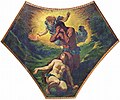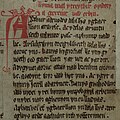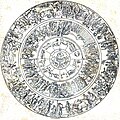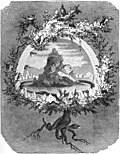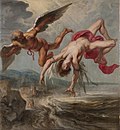Portal:Myths
The Myths Portal


Myth is a genre of folklore consisting primarily of narratives that play a fundamental role in a society. For scholars, this is very different from the vernacular usage of the term "myth" that refers to a belief that is not true. Instead, the veracity of a myth is not a defining criterion.
Myths are often endorsed by religious (when they are closely linked to religion or spirituality) and secular authorities. Many societies group their myths, legends, and history together, considering myths and legends to be factual accounts of their remote past. In particular, creation myths take place in a primordial age when the world had not achieved its later form. Origin myths explain how a society's customs, institutions, and taboos were established and sanctified. National myths are narratives about a nation's past that symbolize the nation's values. There is a complex relationship between recital of myths and the enactment of rituals. (Full article...)
Selected article -

Carnivàle is an American television series set in the United States during the Great Depression. The series traces the disparate storylines of a young carnival worker named Ben Hawkins and Brother Justin Crowe, a preacher in California. The overarching story is built around a good and evil theme, which serves as a human-scaled metaphor within a complex structure of myth and allegory. Samson, who is a dwarf and manages the carnival, sets up the show's mythology with a prologue in the pilot episode, talking of "a creature of light and a creature of darkness" being born "to each generation" preparing for a final battle.
Most mythological elements in Carnivàle relate to so-called Avatars (or Creatures of Light and Darkness), fictional human-like beings with supernatural powers who embody good and evil. In its first season Carnivàle does not reveal its characters as Avatars beyond insinuation, and makes the nature of suggested Avatars a central question. By the second season it is established that Ben is a Creature of Light and Brother Justin a Creature of Darkness. Other than through the characters, the show's good-and-evil theme manifests in the series' contemporary religion, the Christian military order Knights Templar, tarot divination, and in historical events like the Dustbowl and humankind's first nuclear test. Show creator Daniel Knauf did not respond to questions about the mythology but did provide hints about the mythological structure to online fandom both during and after the two-season run of Carnivàle. Nevertheless, many of the intended clues remained unnoticed by viewers. Knauf left fans a production summary of Carnivàle's first season two years after cancellation. This so-called Pitch Document, originally written to give HBO and Knauf's co-writers an overview of the intended storyline, backed up and expanded upon the assumed mythological rules. (Full article...)
Did you know? -
- ...that according to Hindu mythology, the deity Revanta (pictured) was born from the union of the sun-god Surya and his wife Saranya in the form of horse and mare?
- ... that some modern K'iche' Maya revere rival syncretised forms of the pre-Columbian Moon goddess Awilix that are said to be the lovers of St. James?
- ... that in Hopi mythology, the Kachina Nataska enforces good behavior among children?
- ...that in Ovid's Metamorphoses, the love between Acis and Galatea ended when a jealous suitor named Polyphemus killed Acis with a boulder?
Recognised content
Featured Articles:
![]() Ahalya,
Ahalya, ![]() Ancient Egyptian literature,
Ancient Egyptian literature, ![]() King Arthur,
King Arthur, ![]() Ganesha,
Ganesha, ![]() Iravan,
Iravan, ![]() Orion (mythology),
Orion (mythology), ![]() Vampire,
Vampire, ![]() Vithoba
Vithoba
Featured Lists:
![]() List of valkyrie names in Norse mythology
List of valkyrie names in Norse mythology
Good Articles:
![]() 2012 phenomenon,
2012 phenomenon,
![]() Æsir–Vanir War,
Æsir–Vanir War,
![]() Ala (demon),
Ala (demon),
![]() Anu,
Anu,
![]() Aphrodite,
Aphrodite,
![]() Athena,
Athena,
![]() Ardhanarishvara,
Ardhanarishvara,
![]() Battle of Barry,
Battle of Barry,
![]() Bhikshatana,
Bhikshatana,
![]() Catalogue of Women,
Catalogue of Women,
![]() Chamunda,
Chamunda,
![]() Chhinnamasta,
Chhinnamasta,
![]() Consorts of Ganesha,
Consorts of Ganesha,
![]() Cú Chulainn,
Cú Chulainn,
![]() Dhumavati,
Dhumavati,
![]() Dumuzid,
Dumuzid,
![]() Einherjar,
Einherjar,
![]() Eir,
Eir,
![]() Enlil,
Enlil,
![]() Fairy Flag,
Fairy Flag,
![]() Fenrir,
Fenrir,
![]() Gerðr,
Gerðr,
![]() Hel (being),
Hel (being),
![]() Huginn and Muninn,
Huginn and Muninn,
![]() Iðunn,
Iðunn,
![]() Ila (Hinduism),
Ila (Hinduism),
![]() Inanna,
Inanna,
![]() Kabandha,
Kabandha,
![]() Kali,
Kali,
![]() Kamadhenu,
Kamadhenu,
![]() Kangiten,
Kangiten,
![]() Keshi (demon),
Keshi (demon),
![]() Khandoba,
Khandoba,
![]() Kratos (mythology)
Kratos (mythology)
![]() Krishna,
Krishna,
![]() Kubera,
Kubera,
![]() LGBT themes in Hindu mythology,
LGBT themes in Hindu mythology,
![]() Manasa,
Manasa,
![]() Mandodari,
Mandodari,
![]() Matangi,
Matangi,
![]() Matrikas,
Matrikas,
![]() Maya Sita,
Maya Sita,
![]() Mohini,
Mohini,
![]() Myrrha,
Myrrha,
![]() Mythology of Carnivàle,
Mythology of Carnivàle,
![]() Naraka (Hinduism),
Naraka (Hinduism),
![]() Ninurta,
Ninurta,
![]() Prester John,
Prester John,
![]() Prithu,
Prithu,
![]() Putana,
Putana,
![]() Rati,
Rati,
![]() Ratatoskr,
Ratatoskr,
![]() Revanta,
Revanta,
![]() Satyavati,
Satyavati,
![]() Satyr,
Satyr,
![]() Sharabha,
Sharabha,
![]() Shashthi,
Shashthi,
![]() Shiva,
Shiva,
![]() Sif,
Sif,
![]() Tara (Ramayana),
Tara (Ramayana),
![]() Troilus,
Troilus,
![]() Tuisto,
Tuisto,
![]() Valhalla,
Valhalla,
![]() Valkyrie,
Valkyrie,
![]() Vampire folklore by region,
Vampire folklore by region,
![]() Varaha,
Varaha,
![]() Varahi,
Varahi,
![]() Veðrfölnir and eagle
Veðrfölnir and eagle
![]() Zduhać
Zduhać
Wikiversity
Selected creature -
The serpent, or snake, is one of the oldest and most widespread mythological symbols. The word is derived from Latin serpens, a crawling animal or snake. Snakes have been associated with some of the oldest rituals known to humankind and represent dual expression of good and evil. The historian of religions Mircea Eliade observed in The Myth of the Eternal Return, "the serpent symbolizes chaos, the formless and nonmanifested." In The Symbolism of the Cross, Traditionalist René Guénon contended that "the serpent will depict the series of the cycles of universal manifestation," "the indefinitude of universal Existence," and "the being's attachment to the indefinite series of cycles of manifestation." Recent academic book length treatments of serpent symbolism include James H. Charlesworth's The Good and Evil Serpent (2010) and Charles William Dailey's The Serpent Symbol in Tradition (2022). (Full article...)
General images
Subcategories
WikiProjects
Things you can do
- Help with the myth and folklore missing articles project.
- Help create requested articles.
- Help assessment at Wikipedia:WikiProject Mythology/Assessment.
- Place the project banner {{WikiProject Mythology}} on the talk pages of all relevant articles.
- Check the recent changes for recent improvements, vandalism, and other changes.
- Answer requests for mythology articles needing attention: Category:Mythology articles needing attention
- Answer requests for mythology articles needing expert attention: Category:Mythology articles needing expert attention
- Expand articles tagged as mythology stubs: Category:Mythology stubs
- Assist mythology subprojects.
- Add requested photographs of mythology subjects: Category:Wikipedia requested photographs of mythology subjects
Associated Wikimedia
The following Wikimedia Foundation sister projects provide more on this subject:
-
Commons
Free media repository -
Wikibooks
Free textbooks and manuals -
Wikidata
Free knowledge base -
Wikinews
Free-content news -
Wikiquote
Collection of quotations -
Wikisource
Free-content library -
Wikiversity
Free learning tools -
Wiktionary
Dictionary and thesaurus








